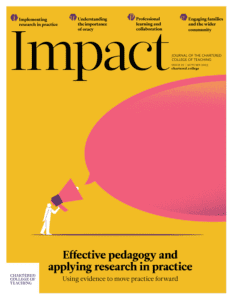A metacognitive approach to developing creativity
Written by: Claire Badger and Jonathan Firth

5 min read
Dr Jonathan Firth, University of Strathclyde, UK
Dr Claire Badger, The Godolphin and Latymer School, UK
Background
Creativity is widely considered to be a vital skill in education. It sits at the pinnacle of the revised Bloom’s taxonomy of skills (Anderson et al., 2001) and has been recognised as important across all curriculum areas (van Broekhoven et al., 2020). It will impact students’ future in the workplace, as well as being embedded throughout the competences that all citizens need (European Commission, 2018). Well beyond their school days, our students will need to find creative solutions to problems.
While the importance of creativity is relatively uncontested, the best way to teach it is controversial. There is a recognition in cognitive psychology that developing transferrable skills is often difficult (e.g. Barnett and Ceci, 2002; Sala et al., 2019). Transfer of creative thinking from one situation to another appears to depend on how it integrates with domain knowl
Join us or sign in now to view the rest of this page
You're viewing this site as a guest, which only allows you to view a limited amount of content.
To view this page and get access to all our resources, join the Chartered College of Teaching (it's free for trainee teachers and half price for ECTs) or log in if you're already a member.
- Anderson LW (ed), Krathwohl DR (ed), Airasian PW et al. (2001) A Taxonomy for Learning, Teaching, and Assessing: A Revision of Bloom’s Taxonomy of Educational Objectives. New York: Longman.
- Badger C, Triccas A and Golland M (2019) Developing learning communities. Impact 5. Available at: https://my.chartered.college/impact_article/developing-learning-communities (accessed 20 June 2023).
- Baer J (2016) Creativity doesn’t develop in a vacuum. New Directions for Child and Adolescent Development 151(1): 9–20.
- Barnett SM and Ceci CJ (2002) When and where do we apply what we learn? A taxonomy for far transfer. Psychological Bulletin 128(4): 612–637.
- Benedek M, Karstendiek M, Ceh SM et al. (2021) Creativity myths: Prevalence and correlates of misconceptions on creativity. Personality and Individual Differences 182: 111068.
- Education Endowment Foundation (EEF) (2018) Metacognition and self-regulated learning. Available at: https://educationendowmentfoundation.org.uk/tools/guidance-reports/metacognition-and-self-regulated-learning (accessed 19 April 2023).
- European Commission (2018) Council recommendation on key competences for lifelong learning. Available at: https://education.ec.europa.eu/focus-topics/improving-quality/key-competences (accessed 19 April 2023).
- Grotzer T and Mittlefehldt S (2012) The role of metacognition in students’ understanding and transfer of explanatory structures in science. In: Zohar A and Dori YJ (eds) Metacognition in Science Education: Trends in Current Research. New York: Springer, pp. 79–99.
- Rotherham AJ and Willingham D (2009) 21st century skills: The challenges ahead. Educational Leadership 67(1): 16–21.
- Sala G, Aksayli ND, Tatlidil KS et al. (2019) Near and far transfer in cognitive training: A second-order meta-analysis. Collabra: Psychology 5(1): 8.
- van Broekhoven K, Cropley D and Seegers P (2020) Differences in creativity across art and STEM students: We are more alike than unalike. Thinking Skills and Creativity 38: 100707.











It is important to understand how metacognitive thinking and creativity go hand in hand. I thought it was interesting to consider how practical strategies can improve creativity such as planning activities that are challenging but not overwhelming or giving time restraints to a task. Some of theses strategies I will definitely consider using with my children.